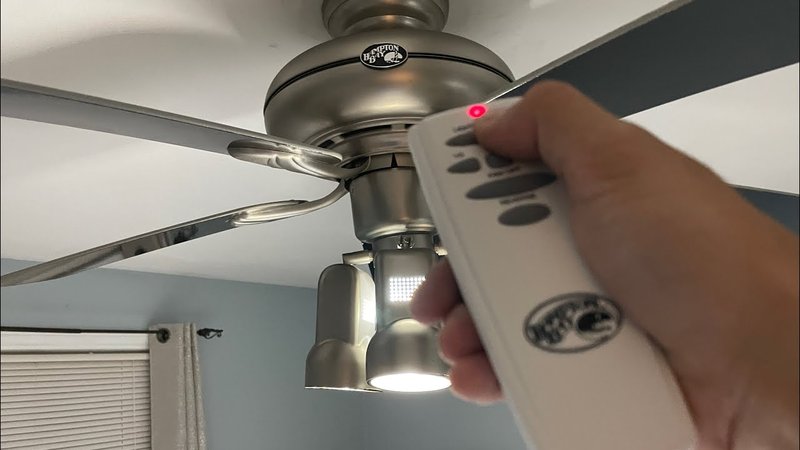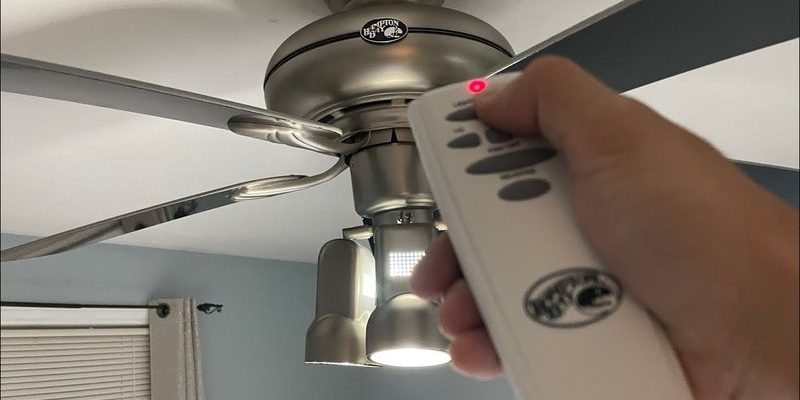
With ceiling fan remotes, especially those from Hampton Bay, the range depends on several sneaky factors you might not even notice. Maybe you want to crank the fan speed without getting out of bed. Or perhaps you’re frustrated that your remote works perfectly in one corner, but nowhere else. Let’s break down the actual working range of these remotes, why it varies, what you can do about it, and how you can make sure your remote stays reliable.
Understanding Hampton Bay Ceiling Fan Remote Technology
The first thing to know is that Hampton Bay ceiling fan remotes aren’t using magic—they’re built on radio frequency (RF) technology. Unlike your old-school TV remotes that need a direct line-of-sight (infrared), Hampton Bay remotes send radio signals through the air. This means you don’t have to point your remote directly at the fan. You could technically change the speed from another room, depending on the actual range.
But here’s the thing: *not* all remotes and receivers are created equal. Hampton Bay typically uses either 303.8 MHz or 304 MHz frequencies for their controls. This helps reduce interference from Wi-Fi or Bluetooth, but it’s far from perfect. Every now and then, things like thick walls, home wiring, or even metal objects can mess with the signal.
The signal is also affected by how the remote syncs or “pairs” with the fan’s receiver. If you’ve ever had to reset or re-code your remote after the batteries died, you know it can be a stubborn process. That handshake between remote and receiver is what ultimately sets the groundwork for range and reliability. If there’s any hiccup here, you might find the range limited—sometimes dramatically.
Typical Range of a Hampton Bay Ceiling Fan Remote
On paper, most Hampton Bay ceiling fan remotes promise a range of around 30 to 50 feet. This is measured in a straight, unobstructed line. So, if you read the manual, you’ll see numbers like “up to 40 feet.” Of course, real-life rooms are rarely empty football fields, and walls get in the way.
In practice, you’ll probably get about 20 to 25 feet in a typical home with a couple of walls in between. Want to control the fan from the far side of your living room? You’ll likely be fine. But if you head out to the garage or try from a different floor, the signal may not make it. I’ve tried changing fan speeds from my hallway, and sometimes it works—sometimes it doesn’t. It almost feels like the signal has a mind of its own.
What often surprises people is that even a closed door can eat up a chunk of that range. If the house is older, with thick plaster walls or a lot of metal in the framing, you might only get 10 to 15 feet of range—and that’s with fresh batteries. That’s why it’s so important to understand not just what the packaging says, but how your actual house affects the remote’s reach.
What Factors Limit Your Hampton Bay Ceiling Fan Remote Range?
Let me explain: it’s not solely about distance. Ceiling fan remote range can drop for a bunch of sneaky reasons. Here are the biggest culprits:
- Obstructions: Walls, furniture, kitchen appliances, and even large mirrors can suck the life out of wireless signals. The more the signal bounces or is absorbed, the less likely it reaches your fan.
- Battery Power: When batteries are weak, the signal the remote sends out gets feeble—think of it like mumbling instead of shouting. Swapping in fresh batteries can be a game changer.
- Signal Interference: Wi-Fi routers, baby monitors, or even wireless cameras can share similar frequencies. If your fan remote starts acting up every time the microwave runs, there’s your culprit.
- Receiver Location: The fan’s receiver is usually tucked inside the canopy near the ceiling. If it’s wedged in at a weird angle, or surrounded by metal, that range can shrink fast.
One thing folks overlook: if you have two Hampton Bay fans with remotes in adjacent rooms, they might accidentally cross-talk (thanks to similar codes). Resetting and re-pairing the remote and receiver can help, but it does mean the code and sync process is crucial for smooth operation.
How to Maximize Your Hampton Bay Ceiling Fan Remote Range
If the remote only works when you stand directly beneath the fan, it might be time to troubleshoot. Here’s what actually helps:
- Replace Batteries Regularly: Don’t wait for the remote to die completely. Weak batteries are the
- Reposition the Receiver: If you’re handy, you can slightly adjust the fan’s receiver so it isn’t blocked by wires or metal parts. Even a small shift can improve the signal path.
- Reset or Re-Pair the Remote: Sometimes, a fresh “code” handshake between your remote and receiver (using those tiny dip switches or a sync button) can clear up interference and improve function.
- Avoid Physical Obstructions: If you can, keep big objects and thick furniture away from the area between where you usually sit and the fan.
- Change Fan or Remote Frequency: If you’ve got interference from other devices, it might be possible to set your fan’s remote to a less crowded frequency (consult your manual for instructions).
Don’t let the techy details scare you off—most of these fixes are beginner-friendly. If you can change a battery or flip a dip switch, you’re halfway there.
Pairing and Syncing: Why It Matters for Range
You might be wondering, “What’s all the fuss about coding and pairing?” Here’s the thing: every Hampton Bay ceiling fan remote uses a *code* or pairing process to talk exclusively to its own fan. This is usually set with little dip switches inside the battery compartment and the receiver module in the fan.
If these two aren’t matched up exactly, or if the code is too similar to that of a neighbor’s remote, you might run into range issues, cross-signals, or total failure. Resetting both sides (remote and receiver) brings them into perfect sync—and can sometimes improve range, especially if an old code was causing interference.
There’s a small storytelling moment here: I once helped a friend troubleshoot his “broken” Hampton Bay remote, only to find out the code in the battery compartment had slipped. We reset it, put in fresh batteries, resynced the code, and suddenly he could control the fan from the hallway again. Sometimes, a simple reset makes all the difference.
Troubleshooting Hampton Bay Ceiling Fan Remote Problems
Things rarely work perfectly forever. If your remote suddenly loses range—or stops working at all—start with the basics:
- Test Fresh Batteries: Always check battery strength first. Even “new” batteries from a drawer can be weak.
- Look for Signal Interference: Try turning off other wireless gadgets nearby. If the remote works better, you’ve nailed the problem.
- Reset and Sync: Follow your fan’s manual to reset both remote and receiver. This often restores lost range.
- Check Receiver Placement: A receiver wedged too deep in the housing may need a slight adjustment (with the power off, of course).
- Inspect for Physical Damage: Drops, spills, or battery corrosion inside the remote can all kill the signal.
Troubleshooting isn’t as intimidating as it seems. If your remote doesn’t improve after these steps, the receiver or remote itself may need replacement. Hampton Bay remotes are generally affordable and easy to swap out.
Universal Remotes vs. Hampton Bay Original Remote
Let’s say your original Hampton Bay remote is lost or broken. Do you need the exact same remote, or will any universal ceiling fan remote do the trick?
Universal ceiling fan remotes often work with Hampton Bay fans, as long as they use compatible frequencies and code settings. Many universal models include setup steps to help you pair or sync with your specific fan. However, *not* all features always carry over (for example, light dimming or programmable timers). And, since universal remotes may use different signal strengths, their range isn’t always equal to the factory Hampton Bay model.
Sometimes, using a universal remote can actually improve your range or reliability—especially if the original remote was an older model. Just make sure to check instructions about code pairing, battery requirements, and compatibility before swapping out.
How the Hampton Bay Ceiling Fan Remote Range Compares to Other Brands
Every brand likes to claim their remotes have the longest range or most reliable connection. In truth, Hampton Bay’s ceiling fan remote range is about average for consumer fans in the U.S.
Most big brands cap out at around 30 to 50 feet of stated range, though real-world use is almost always less. What makes Hampton Bay remotes convenient is that replacement parts and universal remotes are easy to find at hardware stores. Many users report that Hampton Bay remotes work just as well (or better) than store brands like Harbor Breeze and Hunter.
However, some higher-end fan brands use more advanced RF modules, offering longer range or stronger interference resistance. If you have a super open-concept home (say, a loft), you might get slightly longer range from a smart home fan controller or a Wi-Fi integrated system. Still, for most rooms and layouts, a Hampton Bay remote’s performance is perfectly solid.
Honestly, unless you need to control your ceiling fan from another floor or through three thick walls, the standard Hampton Bay remote range should do the job.
Keeping Your Hampton Bay Remote Reliable Over Time
Remotes are like car keys—easy to ignore until they stop working. To keep your Hampton Bay ceiling fan remote reliable (and working at the range you expect), these simple habits help:
- Replace batteries every 6–12 months. Weak batteries cause most signal issues.
- Keep the remote clean and dry. Dust and moisture can short out the contacts or erode the battery compartment.
- Don’t drop or bang the remote. Internal parts can get loose or cracked, reducing signal strength.
- Check your receiver if you move the fan. Adjust the receiver’s placement for the best signal path.
If you notice the fan responding slowly, or the range shrinking, try a quick reset and code check before assuming the worst. A little preventive care goes a long way in avoiding annoying remote range problems.
The actual range of a Hampton Bay ceiling fan remote falls between 20 and 50 feet for most homes, but real life often lands closer to 20–25 feet when you factor in walls, battery strength, and interference. If your remote’s struggling to reach, start with fresh batteries, check for obstructions, and confirm your remote is properly paired with the receiver. For most users and most homes, these steps solve 99% of range headaches.
The bottom line? Hampton Bay ceiling fan remotes aren’t perfect, but with a little care and troubleshooting, they’ll keep you comfy from across the room—no need to get up every time you want a breeze.
